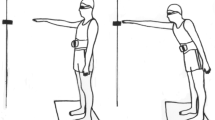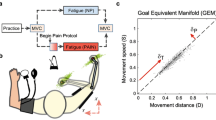Abstract
Neck/shoulder pain is linked to movement repetition, awkward postures, and muscular fatigue. Studies have examined the influence of pain and fatigue on movement characteristics, but few report spatial and temporal characteristics within- and between-dynamic movements. The combined influences of fatigue and pain on these parameters are examined here. A shoulder-injured group (PAIN) (intensity >3/10, duration >3 consecutive months) and an age-sex-matched control group (CTRL) (n = 16 in each) performed a repetitive reaching task to voluntary termination. Kinematics, heart rate, and muscle activity were recorded. Group comparisons were made at the beginning and end of task. Both pain and fatigue changed movement parameters with CTRL subjects adapting to fatigue with increased arm movement, while the PAIN group increased center of mass (CoM) and minimized shoulder movement. Fatigue was associated with decreased arm relative variability, while pain caused increased arm and decreased CoM relative variability. Time to peak velocity tended to indicate increased joint coupling in the CTRL group only. Together, this suggests that despite initial differences in movement strategies, both groups tend to move toward more fixed movement strategies at the end of the task. Those of CTRL are more fixed temporally and spatially (in the arm), whereas the PAIN group adaptations are primarily spatial in nature and appear to focus on controlling CoM.





Similar content being viewed by others
References
Aymard C, Katz R, Lafitte C, Le Bozec S, Penicaud A (1995) Changes in reciprocal and transjoint inhibition induced by muscle fatigue in man. Exp Brain Res 106:418–424
Basmajian J, Blumenstein R (1980) Electrode placement in EMG biofeedback. Williams & Wilkins, Baltimore
Bernard BP (1997) Musculoskeletal disorders and workplace factors. US Department of Health and Human Services, USA
Bernstein N (1967) The co-ordination and regulation of movements. Pergamon Press, Oxford
Bonnard M, Sirin AV, Oddsson L, Thorstensson A (1994) Different strategies to compensate for the effects of fatigue revealed by neuromuscular adaptation processes in humans. Neurosci Lett 166:101–105
Borg G (1982) Psychophysical bases of perceived exertion. Med Sci Sports Exerc 14:377–381
Candotti CT, Loss JF, Pressi AMS, de Souza Castro FA, La Torre M, de Oliveira Melo M, Araujo LD, Pasini M (2008) Electromyography for assessment of pain in low back muscles. Phys Ther 88:1061–1067
Cignetti F, Schena F, Rouard A (2009) Effects of fatigue on inter-cycle variability in cross-country skiing. J Biomech 42:1452–1459
Côté JN, Mathieu P, Levin MF, Feldman AG (2002) Movement reorganization to compensate for fatigue during sawing. Exp Brain Res 146:394–398
Côté JN, Raymond D, Mathieu PA, Feldman AG, Levin MF (2005) Differences in multi-joint kinematic patterns of repetitive hammering in healthy, fatigued and shoulder-injured individuals. Clin Biomech 20:581–590
Côté JN, Feldman AG, Mathieu P, Levin MF (2008) Effects of fatigue on intermuscular coordination during repetitive hammering. Mot Control 12:79–92
Danion F, Latash ML, Li VM, Zatsiorsky VM (2001) The effect of a fatiguing exercise by the index finger on single- and multi-finger force production tasks. Exp Brain Res 138:322–329
Danion F, Li S, Zatsiorsky V, Latash ML (2002) Relations between surface EMG of extrinsic flexors and individual finger forces support the notion of muscle compartments. Eur J Appl Physiol 88:185–188
Enoka RM, Stuart DG (1992) Neurobiology of muscle fatigue. J Appl Physiol 72:1631
Falla D, Rainoldi A, Merletti R, Jull G (2003) Myoelectric manifestations of sternocleidomastoid and anterior scalene muscle fatigue in chronic neck pain patients. Clin Neurophysiol 114:488–495
Farina D, Leclerc F, Arendt-Nielsen L, Buttelli O, Madeleine P (2008) The change in spatial distribution of upper trapezius muscle activity is correlated to contraction duration. J Electromyogr Kinesiol 18:16–25
Forestier N, Nougier V (1998) The effects of muscular fatigue on the coordination of a multijoint movement in human. Neurosci Lett 252:187–190
Fuller JR, Lomond KV, Fung J, Cote JN (2009) Posture-movement changes following repetitive motion-induced shoulder muscle fatigue. J Electromyogr Kinesiol 19:1043–1052
Gogia PP, Sabbahi MA (1994) Electromyograhic analysis of neck muscle fatigue in patients with osteoarthritis of the cervical spine. Spine 19:502–506
Hamill J, van Emmerik RE, Heiderscheit BC, Li L (1999) A dynamical systems approach to lower extremity running injuries. Clin Biomech 14:297–308
Hamill J, Haddad J, Heiderscheit B, van Emmerik RE, Li L (2006) Clinical relevance of variability in coordination. In: Davids K, Bennett S, Newell K (eds) Movement system variability. Human Kinetics, Champaign, pp 153–166
Hodges PW, Moseley GL (2003) Pain and motor control of the lumbopelvic region: effect and possible mechanisms. J Electromyogr Kinesiol 13:361–370
Huffenus A-F, Amarantini D, Forestier N (2006) Effects of distal and proximal arm muscles fatigue on multi-joint movement organization. Exp Brain Res 170:438–447
Jensen BR, Laursen B, Sjogaard G (2000) Aspects of shoulder function in relation to exposure demands and fatigue—a mini review. Clin Biomech 15(Suppl 1):17–20
Lamoth CJC, Meijer OG, Daffertshofer A, Wuisman P, Beek PJ (2006) Effects of chronic low back pain on trunk coordination and back muscle activity during walking: changes in motor control. Eur Spine J 15:23–40
Latash ML (2000) There is no motor redundancy in human movements. There is motor abundance. Mot Control 4:257–259
Lund JP, Donga R, Widmer CG, Stohler CS (1991) The pain-adaptation model: a discussion of the relationship between chronic musculoskeletal pain and motor activity. Can J Physiol Pharmacol 69:683–694
Madeleine P, Lundager B, Voigt M, Arendt-Nielsen L (1999) Shoulder muscle co-ordination during chronic and acute experimental neck-shoulder pain. An occupational pain study. Eur J Appl Physiol 79:127–140
Madeleine P, Lundager B, Voigt M, Arendt-Nielsen L (2003) The effects of neck-shoulder pain development on sensory-motor interactions among female workers in the poultry and fish industries. A prospective study. Int Arch Occup Environ Health 76:39–49
Madeleine P, Mathiassen SE, Arendt-Nielsen L (2008) Changes in the degree of motor variability associated with experimental and chronic neck-shoulder pain during a standardised repetitive arm movement. Exp Brain Res 185:689–698
Mathiassen SE, Moller T, Forsman M (2003) Variability in mechanical exposure within and between individuals performing a highly constrained industrial work task. Ergonomics 46:800–824
Moseley GL, Hodges PW (2006) Reduced variability of postural strategy prevents normalization of motor changes induced by back pain: a risk factor for chronic trouble? Behav Neurosci 120:474–476
Newell KM, van Emmerik REA, Lee D, Sprague RL (1993) On postural stability and variability. Gait Posture 1:225–230
Nussbaum MA (2003) Postural stability is compromised by fatiguing overhead work. Am Ind Hyg Assoc J 64:56–61
Palmerud G, Kadefors R, Sporrong H, Jarvholm U, Herberts P (1995) Voluntary redistribution of muscle activity in human shoulder muscles. Ergonomics 38:806–815
Psek JA, Cafarelli E (1993) Behavior of coactive muscles during fatigue. J Appl Physiol 74:170–175
Selen L, Beek P, van Dieën J (2007) Fatigue-induced changes of impedance and performance in target tracking. Exp Brain Res 181:99–108
Simmonds MJ (2006) Measuring and managing pain and performance. Man Ther 11:175–179
Sparto PJ, Parnianpour M, Reinsel TE, Simon S (1997) The effect of fatigue on multijoint kinematics and load sharing during a repetitive lifting test. Spine 22:2647–2654
Stergiou N, Harbourne RT, Cavanaugh JT (2006) Optimal movement variability: a new theoretical perspective for neurologic physical therapy. J Neurol Phys Ther 30:120–129
Sterling M, Jull G, Wright A (2001) The effect of musculoskeletal pain on motor activity and control. J Pain 2:135–145
Szeto GPY, Straker LM, O’Sullivan PB (2005) EMG median frequency changes in the neck-shoulder stabilizers of symptomatic office workers when challenged by different physical stressors. J Electromyogr Kinesiol 15:544–555
van der Windt D, Thomas E, Pope DP, de Winter AF, Macfarlane GJ, Bouter LM, Silman AJ (2000) Occupational risk factors for shoulder pain: a systematic review. Occup Environ Med 57:433–442
van Dieën JH, Toussaint HM, Maurice C, Mientjes M (1996) Fatigue-related changes in the coordination of lifting and their effect on low back load. J Mot Behav 28:304–314
Van Emmerik REA, Wagenaar RC, Winogrodzka A, Wolters EC (1999) Identification of axial rigidity during locomotion in Parkinson disease. Arch Phys Med Rehabil 80:186–191
Zakaria D, Robertson J, MacDermid J, Hartford K, Koval J (2002) Work-related cumulative trauma disorders of the upper extremity: navigating the epidemiologic literature. Am J Ind Med 42:258–269
Acknowledgments
Karen Lomond was supported by a scholarship from the Institut de recherche Robert-Sauvé en santé et en sécurité du travail (IRSST). This work has been supported by an NSERC Discovery Grant, the Canada Foundation for Innovation (CFI), and the Jewish Rehabilitation Hospital Foundation. The authors wish to thank Evelyne Boulay, Kim Emery, Jason Fuller, Eva Panetta, Charlene Leduc-Poitras, and David Savoca for their assistance in data collection and preliminary analyses.
Author information
Authors and Affiliations
Corresponding author
Rights and permissions
About this article
Cite this article
Lomond, K.V., Côté, J.N. Movement timing and reach to reach variability during a repetitive reaching task in persons with chronic neck/shoulder pain and healthy subjects. Exp Brain Res 206, 271–282 (2010). https://doi.org/10.1007/s00221-010-2405-1
Received:
Accepted:
Published:
Issue Date:
DOI: https://doi.org/10.1007/s00221-010-2405-1




